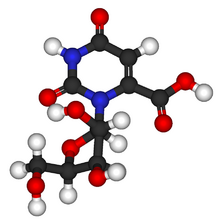Chemistry:Orotidine
From HandWiki

| |

| |
| Names | |
|---|---|
| IUPAC name
2,6-Dioxo-3-(β-D-ribofuranosyl)-1,2,3,6-tetrahydropyrimidine-4-carboxylic acid
| |
| Systematic IUPAC name
3-[(2R,3R,4S,5R)-3,4-Dihydroxy-6-(hydroxymethyl)oxolan-2-yl]-2,6-dioxo-1,2,3,6-tetrahydropyrimidine-4-carboxylic acid | |
| Other names
3-Ribofuranosylorotic acid, 6-Carboxyuridine, orotate riboside
| |
| Identifiers | |
3D model (JSmol)
|
|
| ChemSpider | |
PubChem CID
|
|
| UNII | |
| |
| |
| Properties | |
| C10H12N2O8 | |
| Molar mass | 288.213 g/mol |
| Melting point | 200 °C (392 °F; 473 K) |
Except where otherwise noted, data are given for materials in their standard state (at 25 °C [77 °F], 100 kPa). | |
| Infobox references | |
Orotidine is a nucleoside formed by attaching orotic acid to a ribose ring via a β-N1-glycosidic bond. It is found in bacteria, fungi and plants. It was first isolated in 1951 from the fungus Neurospora by A. Michael Michelson, William Drell, and Herschel K. Mitchell.[1] In humans, orotidine occurs as its 5'-phosphate (orotidylic acid), which is an intermediate in pyrimidine nucleotide biosynthesis (cytidine and uridine) that are found in nucleic acids. Orotidine itself is not a component of nucleic acid. Large amounts of orotidine are excreted in the urine of cancer patients treated with 6-azauridine.
The symbol commonly used for orotidine is O or Ord.
Notes
- ↑ A. Michael Michelson; William Drell; Herschel K. Mitchell (1951). "A new ribose nucleoside from Neurospora: "orotidine"". Proc Natl Acad Sci USA 37 (7): 396–399. doi:10.1073/pnas.37.7.396. PMID 14853953. Bibcode: 1951PNAS...37..396M.
 |

